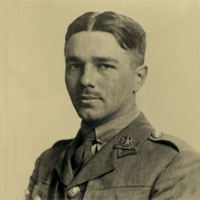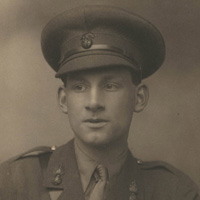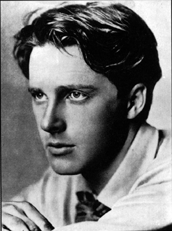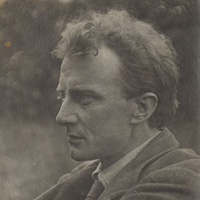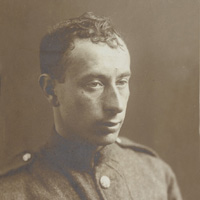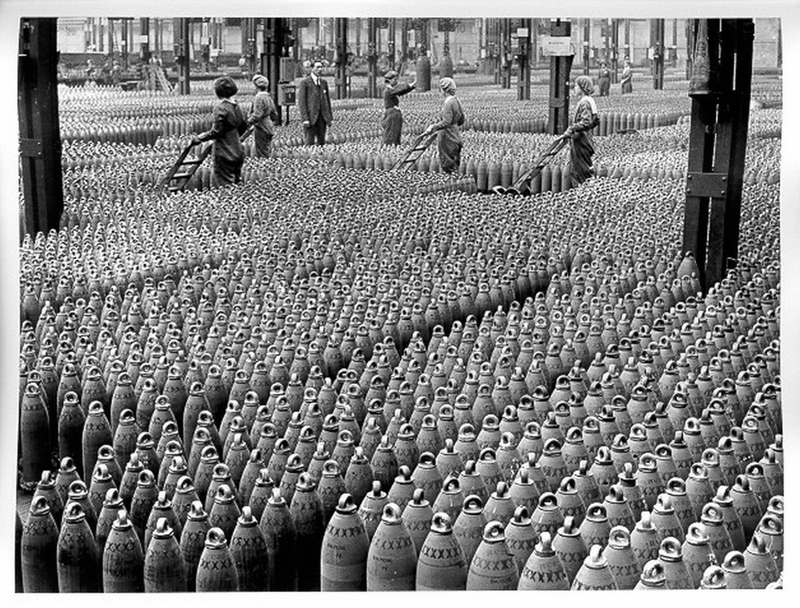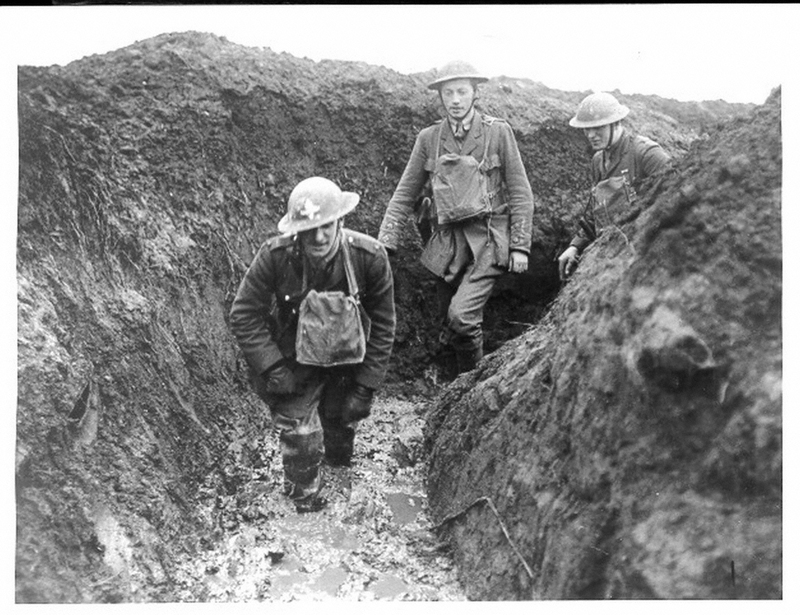Siegfried Sassoon (1886-1967)
Biography | Analysis of 'Survivors' | More Poems by Sassoon | Extracts from Sassoon's Diaries |
Audio clip of Siegfried Sassoon reading "The Power and the Glory" Stanbrooke Abbey 1960, © The Imperial War Museum
Biography
With war on the horizon, a young Englishman whose life had heretofore been consumed with the protocol of fox-hunting, said goodbye to his idyllic life and rode off on his bicycle to join the Army. Siegfried Sassoon was perhaps the most innocent of the war poets. John Hildebidle has called Sassoon the "accidental hero." Born into a wealthy Jewish family in 1886, Sassoon lived the pastoral life of a young squire: fox-hunting, playing cricket, golfing and writing romantic verses.
Being an innocent, Sassoon's reaction to the realities of the war were all the more bitter and violent — both his reaction through his poetry and his reaction on the battlefield (where, after the death of fellow officer David Thomas and his brother Hamo at Gallipoli, Sassoon earned the nickname "Mad Jack" for his near-suicidal exploits against the German lines — in the early manifestation of his grief, when he still believed that the Germans were entirely to blame). As Paul Fussell said: "now he unleashed a talent for irony and satire and contumely that had been sleeping all during his pastoral youth" (The Great War and Modern Memory, Paul Fussel (OUP, 1977). Sassoon also showed his innocence by going public with his protest against the war (as he grew to see that insensitive political leadership was the greater enemy than the Germans). Luckily, his friend and fellow poet Robert Graves convinced the review board that Sassoon was suffering from shell-shock and he was sent instead to the military hospital at Craiglockhart where he met and influenced Wilfred Owen.
Sassoon is a key figure in the study of the poetry of the Great War: he brought with him to the war the idyllic pastoral background; he began by writing war poetry reminiscent of Rupert Brooke; he mingled with such war poets as Robert Graves and Edmund Blunden; he spoke out publicly against the war (and yet returned to it); he influenced and mentored the then unknown Wilfred Owen; he spent thirty years reflecting on the war through his memoirs; and at last he found peace in his religious faith. Some critics found his later poetry lacking in comparison to his war poems. Sassoon, identifying with Herbert and Vaughan, recognized and understood this: "my development has been entirely consistent and in character" he answered, "almost all of them have ignored the fact that I am a religious poet."
Biography by: Robert Means, English Literature Librarian, Harold B. Lee Library, Brigham Young University.
Survivors
No doubt they'll soon get well; the shock and strain
Have caused their stammering, disconnected talk.
Of course they're 'longing to go out again,' -
These boys with old, scared faces, learning to walk.
They'll soon forget their haunted nights; their cowed
Subjection to the ghosts of friends who died,-
Their dreams that drip with murder; and they'll be proud
Of glorious war that shatter'd all their pride...
Men who went out to battle, grim and glad;
Children, with eyes that hate you, broken and mad.Craiglockhart. October, 1917.
Collected Poems 1908–1956, Siegfried Sassoon (Faber and Faber, 1984) p. 90 © George Sassoon
Literary Criticism of 'Survivors'
-
'Survivors' (Title)
Written in October 1917 at Craiglockhart hospital, during Sassoon's forced convalescence after his declaration against the war. -
'No doubt they'll soon get well' (L.1)
The opening line gives the reader a sense of misleading hope. The throw- away feeling emphasised by the assured 'No doubt' calls to mind the sinister complacency of 'Does It Matter?'. -
'stammering, disconnected talk' (L.2)
One of the symptons of shell-shock or 'neurasthenia' (as it was then termed) is a stammer, and a failure to string sentences together coherently. The conditions of some of the patients at Craglockhart are described powerfully in 'Regeneration' the opening book to Pat Barker's WWI trilogy (Regeneration, Pat Barker (Penguin Books, 1992)). -
'Of course they're 'longing to go out again,'' (L.3)
Again the disassociated, unfeeling voice make its presence felt. The flippant remark, suggesting that all soldiers were willing to return to the front, is typical of the attitude Sassoon perceived in the non-combatants at home. -
'These boys with old, scared faces' (L.4)
Sassoon contrasts the youth and innocence of the soldiers with the ageing process of the war. Yet, although these men are made old before their time, they are also reduced to infants ('Children', L.10) having to re-learn such basic processes as how to walk. -
'They'll soon forget...of friends who died' (Ll.5-6)
On Sassoon's return to England in April, 1917, after receiving an injury earlier that year, his anti-war sentiments reached new heights. Angered by the attitude he perceived in the people who remained in England, and troubled by visions and nightmares in which he saw corpses littering the streets, he was moved to publish his famous declaration against the war, which ultimately led to his spell at Craiglockhart.These nightmares continued during his convalescence at the hospital, and if it were not for the pioneering work by his psychiatrist, Dr. W. H. R. Rivers (neurologist and anthropologist), it is probable that his decline would have led to a total break-down.
The 'cowed subjection' of the dreamer calls to mind a similar sense of guilt expressed in the poem 'Sick Leave'. Here Sassoon, once again asleep, pictures 'the noiseless dead' (L.2) who seek him out, reproaching him for not being back at the front with his Battalion.
-
'- and they'll be proud/Of glorious war that shatter'd all their pride' (Ll.7-8)
Again the poet presents us with a sense of hope, immediately reversed by a harsh reminder of brutal reality. The survivors, once they have managed to forget the nightmares and visions of their dead comrades, will then be able to reflect on the 'glorious war' with pride; but this, in turn, will remind them of their time spent overcoming the horror, when they had no self-esteem having been reduced to helpless children. -
'with eyes that hate you' (L.10)
Sassoon ends the poem in an accusatory manner, no doubt directed at the supporters of the War, the people who can so easily push soldiers back to the front without ever knowing the horrors of trench warfare.
See the Siegfried Sassoon Collection.
Page Notes
- Siegfried Sassoon: Declaration against the War
- I am making this statement as an act of wilful defiance of military authority, because I believe that the War is being deliberately prolonged by those who have the power to end it. I am a soldier, convinced that I am acting on behalf of soldiers. I believe that this War, on which I entered as a war of defence and liberation, has now become a war of aggression and conquest. I believe that the purpose for which I and my fellow soldiers entered upon this war should have been so clearly stated as to have made it impossible to change them, and that, had this been done, the objects which actuated us would now be attainable by negotiation. I have seen and endured the sufferings of the troops, and I can no longer be a party to prolong these sufferings for ends which I believe to be evil and unjust. I am not protesting against the conduct of the war, but against the political errors and insincerities for which the fighting men are being sacrificed. On behalf of those who are suffering now I make this protest against the deception which is being practised on them; also I believe that I may help to destroy the callous complacency with which the majority of those at home regard the contrivance of agonies which they do not share, and which they have not sufficient imagination to realize.
- The War Poets, Robert Giddings (Bloomsbury, 1990) p.111
- I am making this statement as an act of wilful defiance of military authority, because I believe that the War is being deliberately prolonged by those who have the power to end it. I am a soldier, convinced that I am acting on behalf of soldiers. I believe that this War, on which I entered as a war of defence and liberation, has now become a war of aggression and conquest. I believe that the purpose for which I and my fellow soldiers entered upon this war should have been so clearly stated as to have made it impossible to change them, and that, had this been done, the objects which actuated us would now be attainable by negotiation. I have seen and endured the sufferings of the troops, and I can no longer be a party to prolong these sufferings for ends which I believe to be evil and unjust. I am not protesting against the conduct of the war, but against the political errors and insincerities for which the fighting men are being sacrificed. On behalf of those who are suffering now I make this protest against the deception which is being practised on them; also I believe that I may help to destroy the callous complacency with which the majority of those at home regard the contrivance of agonies which they do not share, and which they have not sufficient imagination to realize.
- Craiglockhart Hospital
- The large victorian building at Craiglockhart was requisitioned by the military in 1916 and turned into a war hospital for the treatment of shell shocked officers. In 1917, Wilfred Owen was sent to Craiglockhart to recover from "Neurasthenia" (a more scientific term for "shell shock"). At around the same time as this, Siegfried Sassoon was sent there after having his Declaration against the War read out in the House of Commons, his friend and fellow poet Robert Graves having convinced the review board that Sassoon was suffering from shell-shock (although he clearly wasn't), thus avoiding a Court Martial.
- Owen met Sassoon at Craiglockhart in August 1917 and was strongly influenced and encouraged by him. Also, the work of the doctors at Craiglockhart was ground-breaking for the time and the friendship between Sassoon and his Doctor, Dr. W.H.R. Rivers was to become life long — a fictionalised account of the beginning of this relationship is documented in Pat Barker's novel Regeneration (Penguin, 1992), soon to be released as a motion picture.
- Napier University War Poets Collection (at Craiglockhart)
Next:
